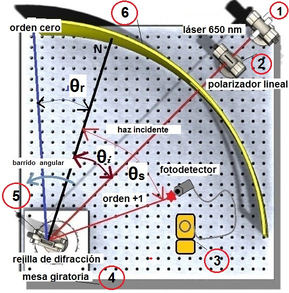Manufacture of an optical prototype for light-matter interaction experiments
DOI:
https://doi.org/10.37636/recit.v225865Keywords:
Surface Plasmon polaritons, Additive manufacturing, Nanotechnology.Abstract
An optical prototype was fabricated to perform measurements of surface plasmon polaritons in light beams diffracted at angles of less than 900. Experiments were developed to identify the excitation resonant angle of surface polariton plasmons by a diffraction grating with a pitch greater than the wavelength of the light signal. In the laboratory tests, measurements of the intensity curve of the diffracted light signal were carried out in the +1 and -1 orders. The experimental results were consistent with the theoretical approach. Based on the above, it is concluded that it is possible to excite surface plasmon polaritons, using the technique of the metallic diffraction grating with a wavelength shorter than the space frequency of the grid. The achieved optical prototype turns out to be very flexible for future applications in the measurement of plasmons. This is possible thanks to the speed at which it is possible to modify the frames and their assemblies for the alignment of the optical elements: laser diode, rugged metallic surface, linear polarizer. Likewise, the absolute control in the incident angle apparatus, and the ease of exchanging the light source and the rough metal surface, open wide possibilities for testing new hypotheses for the excitation conditions of surface plasmon polaritons.
Downloads
References
V. M. Shalaev, y S. Kawata, "Nanophotonics with Surface Plasmons," Elsevier, vol. 1, pp. 3-32, 2007. https://doi.org/10.1016/B978-044452838-4/50000-X DOI: https://doi.org/10.1016/B978-044452838-4/50000-X
H. Raether, "Surface Plasmons on Smooth and Rough Surfaces and Gratings," Springer, Berlin, vol. 1, pp. 4-39, 1988. https://doi.org/10.1007/BFb0048319 DOI: https://doi.org/10.1007/BFb0048319
S. A. Maier, "Plasmonics: Fundamentals and Applications," Springer, New York, vol. 1, pp. 39-42, 2007. https://doi.org/10.1007/0-387-37825-1_3 DOI: https://doi.org/10.1007/0-387-37825-1_3
V. V. Mitin, V. A. Kochelap, y M. A. Stroscio, Introduction to Nanoelectronics, Cambridge University Press, United Kingdom, vol. 1, pp. 242-321, 2008. https://doi.org/10.1017/CBO9780511809095 DOI: https://doi.org/10.1017/CBO9780511809095
G. E. Moore, "Cramming more components onto integrated circuits," Electronics, vol. 38, pp. 82-85, 1965. https://doi.org/10.1109/JPROC.1998.658762 DOI: https://doi.org/10.1109/JPROC.1998.658762
A. Otto, "Excitation of nonradiative surface plasma waves in silver by the method of frustrated total reflection,” Zeitschrift für Physik, vol. 216(4), pp. 398-410, 1968. https://doi.org/10.1007/BF01391532 DOI: https://doi.org/10.1007/BF01391532
J. Homola, I. Koudela, y S. S. Yee, "Surface plasmon resonance sensors based on diffraction gratings and prism couplers: sensitivity comparison,” Sensors and Actuators B., vol. 54, pp. 16-24, 1999. https://doi.org/10.1016/S0925-4005(98)00322-0 DOI: https://doi.org/10.1016/S0925-4005(98)00322-0
M.A. Ponce-Camacho, J. Villavicencio, R. Romo, "Procedimiento para Controlar la Intensidad de una Señal de Luz", patente en trámite, expediente MX/a/2016/015972, No. de folio 12759, México, 2016.
E. Kretschmann, y H. Raether, "Radiative decay of nonradiative surface plasmons excited by light. Z", Naturforsch, A, vol. 23, pp. 2135, 1968. https://doi.org/10.1515/zna-1968-1247 DOI: https://doi.org/10.1515/zna-1968-1247
S. Babar y J. H. Weaver, "Optical constants of Cu, Ag, and Au revisited", Appl. Opt. vol. 54, pp. 477-481, 2015. https://doi.org/10.1364/AO.54.000477 DOI: https://doi.org/10.1364/AO.54.000477

Published
How to Cite
Issue
Section
Categories
License
Copyright (c) 2019 Miguel Ángel Ponce-Camacho, Jorge Alberto Villavicencio Aguilar, Roberto Romo Martínez

This work is licensed under a Creative Commons Attribution 4.0 International License.
The authors who publish in this journal accept the following conditions:
The authors retain the copyright and assign to the journal the right of the first publication, with the work registered with the Creative Commons Attribution license 4.0, which allows third parties to use what is published as long as they mention the authorship of the work and the first publication in this magazine.
Authors may make other independent and additional contractual agreements for the non-exclusive distribution of the version of the article published in this journal (eg, include it in an institutional repository or publish it in a book) as long as they clearly indicate that the work it was first published in this magazine.
Authors are allowed and encouraged to share their work online (for example: in institutional repositories or personal web pages) before and during the manuscript submission process, as it can lead to productive exchanges, greater and more quick citation of published work (see The Effect of Open Access).











